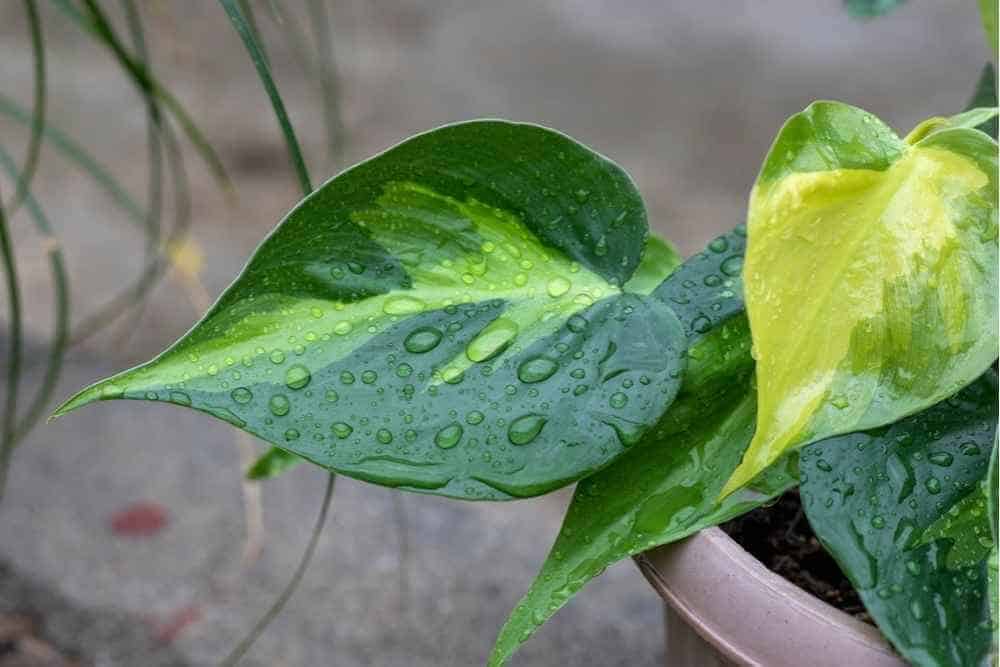Never taken care of a plant before? Thinking of adding green to your space? Just want another plant (don’t we all)?
Enter the easygoing heart-leaf philodendron.
This humble houseplant is loved for its heart-shaped leaves and elegant vining stems. It’s not fussy about care needs — just give it well-draining potting mix and bright, indirect light!
Ready to have your heart stolen by the heart-leaf philodendron? Learn how to care for this plant no matter where it grows in your home.
Light Requirements | Potting Mix | Plant Environment | Watering | Repotting | Pruning | Fertilising | Climbing or Trailing | Propagating | Common Problems
Presenting the Philodendron Hederaceum

Whether you’re a beginner plant parent or a seasoned gardener, lots of us love the heart-leaf philodendron.
Philodendron hederaceum is also known as the heartleaf philodendron or sweetheart plant. No surprise about why — just look at its dark green, heart-shaped leaves.
Heart-leaf philos are evergreen plants native to tropical regions in South and Central America. They have a climbing habit in the wild, since they latch onto trees to reach upwards and get more sun.
These popular houseplants are aroids, belonging to the same Araceae family as monsteras and aglaonemas.
Besides the standard P. hederaceum, there are many popular heart-leaf philodendron varieties, such as:
- Philodendron Brasil
- Philodendron Lemon Lime
- Philodendron Micans
Growing Conditions for Heart-Leaf Philodendron
P. hederaceum is fairly low-maintenance, whether it’s grown indoors or out on the patio.
So long as your heart-leaf philodendrons have a good potting mix and enough light, they’ll be happy!
Light requirements
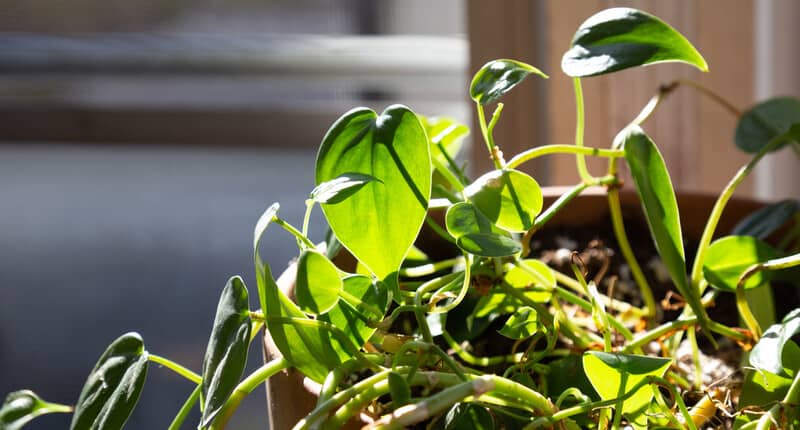
It’s a key question — how much sun does a heart-leaf philodendron need? Try for at least 6 hours of bright, indirect light.
Ideally, place your philodendron by an east or northeast-facing window where it can get indirect morning sun. Keep it out of direct sunlight, especially in the afternoon, or the leaves may get scorched.
Unlike variegated cultivars, a heart-leaf philodendron can tolerate lower levels of light. As long as you can see the sky from the plant’s position, it’ll do okay, but the stems can become straggly or leggy.
If you don’t have a good window, consider getting a full-spectrum grow light. Don’t run it for longer than 10 hours, though — your plant needs “sleep,” too!
Soil or potting mix
A heart-leaf philodendron prefers a chunky, well-draining, soilless potting mix that’s slightly acidic.
The ideal philodendron soil is an aroid mix, like those for monsteras and alocasias. Alternatively, amend regular potting soil with perlite, coir, or bark.
Be sure to choose a container that has several drainage holes, like a nursery pot.
Plant environment
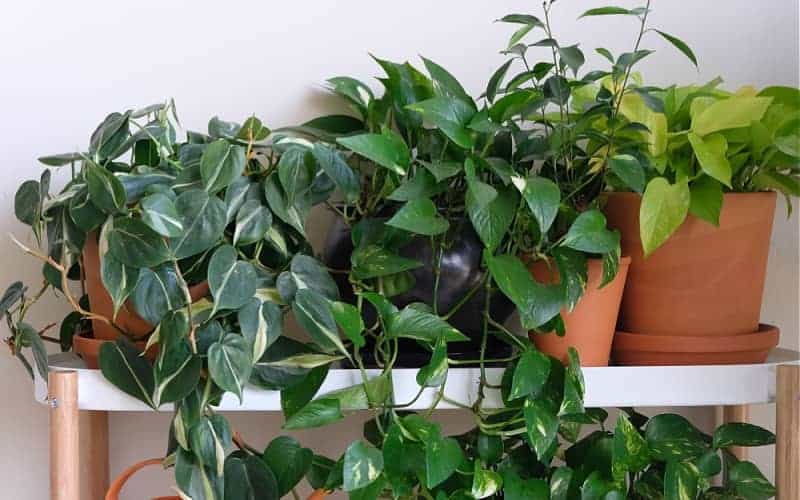
Philodendrons are endemic to tropical rainforests, so they like warmth and humidity.
Heart-leaf philos will do fine in typical home humidity levels of 50–70%, but can tolerate humidity down to 40%.
You can group your P. hederaceum with other plants to increase humidity or keep it in an indoor greenhouse. No need to mist — that doesn’t actually do much!
These plants don’t tolerate too-cold or too-hot conditions, so keep indoor temperatures around 15–38ºC. For outdoor philodendrons, bring them indoors in the winter.
Heart-Leaf Philodendron Plant Care
Like other philodendron plants, P. hederaceum isn’t too fussy about water or pruning.
Still, proper care will keep your plant healthy and happy!
When to water a heart-leaf philodendron
As a general rule, water a heart-leaf philodendron when the potting mix is three-quarters of the way dry.
How often you water will depend on conditions like light, weather, and pot size. Stick your finger or a wooden chopstick into the pot to check the moisture levels.
It’s important not to overwater your plant! Watering too often leads to soggy soil and causes root rot.
However, don’t let your philodendron dry out for too long, either. Philodendrons don’t store water, so they will wilt if they don’t get enough moisture.
You can keep your plant in a clear pot so you can see whether the soil has dried out.
When to repot a heart-leaf philodendron
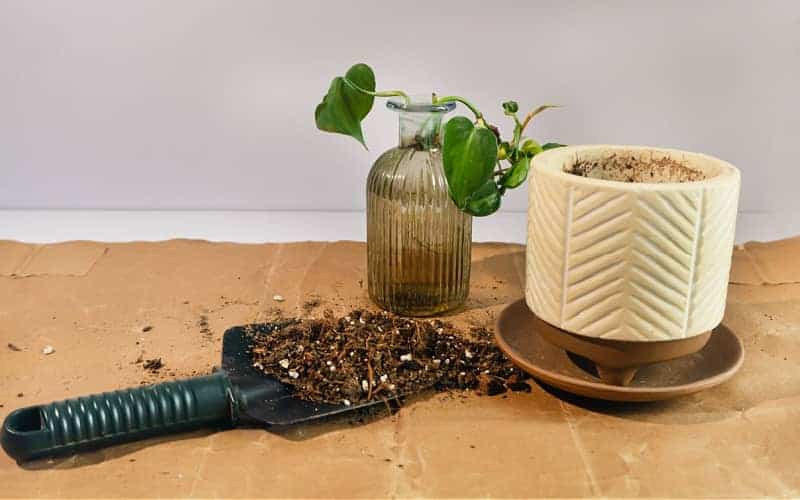
In the right conditions, heart-leaf philos can be pretty fast-growing! Once the plant becomes rootbound or outgrows its container, it’s time to repot.
Some signs that your philodendron needs repotting include:
- Slow or minimal growth
- Roots circling or poking out of the pot base
- Soil that dries out quickly or more frequently
Choose a pot size that’s about 2–6cm (1–2in) bigger than the current container. Don’t go too large, or the roots could suffocate from too much soil and moisture.
To repot your heart-leaf philodendron, carefully wiggle or push the plant out of its container. Check the potting mix — if there are no issues (e.g. hydrophobic soil), leave it intact.
Transfer the roots and soil together into the new pot, then fill it in with additional potting mix. Give the new pot a little shimmy to settle the plant before watering thoroughly.
Do you need to prune a heart-leaf philodendron?
You’ll only need to prune a healthy heart-leaf philodendron if it’s getting leggy or unruly. Trimming lets you maintain the plant’s shape and encourages bushier growth.
However, you should prune your heart-leaf philo ASAP if you notice:
- Pest infestations
- Dead or diseased leaves and stems
- Balding (lack of growth at soil level)
When pruning your philodendron, use a sanitised pair of shears. (Rubbing alcohol or hydrogen peroxide works fine.)
For stems, you want to cut close to the soil. Count 2–3 leaf nodes from the base of the stem and make a clean cut between nodes.
Trim off leaves as close to the stem as possible.
Do heart-leaf philodendrons need fertiliser?
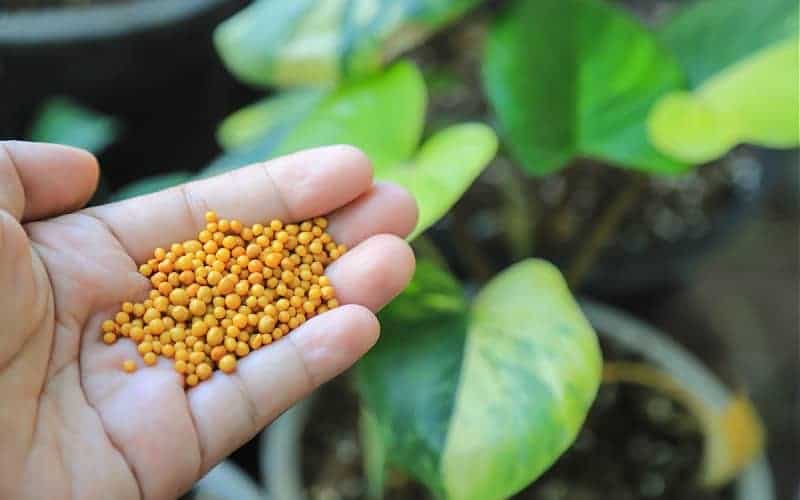
Fertiliser isn’t usually needed for houseplants, but it can provide a boost if you use soilless potting mixes.
Apply a balanced houseplant fertiliser every 6–8 weeks during spring and summer. In cooler or rainy seasons, you can add fertiliser every 10–12 weeks (or not at all).
If your plants stay under grow lights year-round, maintain a regular fertiliser schedule.
Do heart-leaf philodendrons climb or hang?
P. hederaceum can either trail or climb, though in the wild, they usually climb up trees.
If you want bigger leaves, give your philodendron some support — usually a trellis, moss pole, or wood plank. Attach the plant using garden ties or clips placed between leaf nodes.
For a trailing philodendron plant, place the pot up high on a shelf or wall. You can also use a hanging pot.
Be mindful of the stems, as they can become leggy or tangled if allowed to grow too long.
Propagating a Heart-Leaf Philodendron
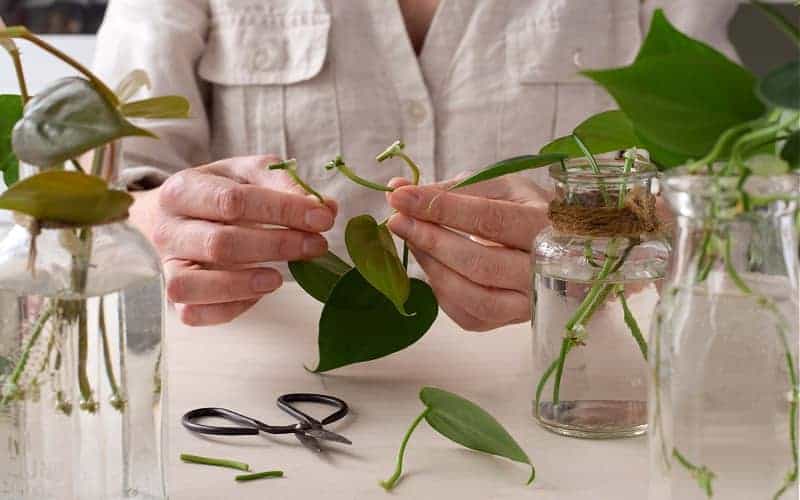
It’s easiest to propagate your heart-leaf philodendron in water!
Take cuttings from your philodendron plant — preferably a tip cutting from the end of the stem. You want around 5cm of stem with several nodes or aerial roots and at least one healthy leaf.
Strip the bottom half of the stem, then place it in a clear jar. Add enough water to cover the nodes without touching any leaves.
Keep the cuttings in indirect sunlight or a grow light. Philodendrons root quickly, with new roots usually appearing after 6–8 weeks.
When you start seeing secondary roots, it’s safe to transfer your propagations. Plant them in a small pot (10cm or less) with chunky potting mix, and keep it moist as the roots adjust.
For mid-stem cuttings with few to no leaves, place them in a small translucent box filled with sphagnum moss or perlite. Moisten the moss/perlite and position the cuttings so the nodes are partially covered.
Place the box under indirect light, and open it once a day to air it out. Lightly mist the propagation medium as necessary until the roots come in.
Common Heart-Leaf Philodendron Problems

Heart-leaf philodendrons are fairly resilient, but improper care or pests can cause some problems.
Why is my heart-leaf philodendron turning yellow?
Several yellow, wilting leaves are a typical symptom of overwatering.
Keep in mind that “overwatering” doesn’t mean giving too much water, but rather watering too often. Soggy potting mix will suffocate the roots and lead to root rot.
Skip watering and check on your plant’s roots. If they’re black, mushy, or smelly, that’s a sign of rot.
Cut off dying roots and immediately repot the plant in fresh soil. Wait a few days before watering again so the roots can recover.
If you’re only seeing 1–2 yellow leaves, though, that’s just part of the life cycle! As leaves age, they turn yellow and fall off as new growth comes in.
Why is my heart-leaf philodendron curling?
There are three likely causes of curling philodendron leaves: underwatering, low humidity, or too much direct sunlight.
Foliage that’s brown and crispy usually signals a lack of moisture. Check the potting mix to see if it’s too dry — if yes, give your plant a good soak in a container of tepid water.
You can add humidity by grouping plants together, creating an indoor greenhouse, or using a humidifier.
If the curling leaves also have brown tips or spots, the plant is getting too much sun! Move it away from the window or, for outdoor plants, place them in partial shade out of the afternoon sun.
What are heart-leaf philodendron pests and diseases?
Pest infestations can sometimes attack your heart-leaf philodendron, especially outdoor plants.
Common houseplant pests that affect philodendrons include:
- Fungus gnats
- Spider mites
- Thrips
Check the leaves and soil for signs of infestation. Some treatment options include insecticidal soap, isopropyl alcohol, or a hydrogen peroxide soak.
Healthy heart-leaf philos aren’t very susceptible to disease, but look out for powdery mildew or leaf spot. You can treat fungal diseases with an organic fungicide or neem oil.
More to Know About the Heart-Leaf Philodendron

Here are a few more things to know about growing and caring for P. hederaceum!
Heart-leaf philodendron vs. pothos: What’s the difference?
The main differences between a heart-leaf philodendron and pothos are the leaves and aerial roots.
Heart-leaf philodendron plants have thin, dark green leaves with a smooth texture and a heart shape. They also have thin aerial roots and new growth that emerges from the long vine stem.
On the other hand, pothos plants have thicker, waxy leaves with a more elongated or arrow shape. They have stubby aerial roots, and new leaves unfurl from existing ones.
Is heart-leaf philodendron toxic to cats?
Yes, heart-leaf philodendrons are toxic to cats, dogs, and other pets.
All parts of the plant contain calcium oxalate crystals, which cause adverse reactions when ingested. Common symptoms include mouth swelling, drooling, and vomiting.
If you think your pet has licked or chewed your plant, take it to a vet immediately.
Can philodendrons grow in water?
They can! Many philodendrons can be grown in hydroponic (water-based) setups, and they even make great aquarium plants.
When growing plants in water, keep an eye on the container — you need to change the water if it becomes murky or green (a sign of algae).
Use a soluble or hydroponic fertiliser to feed your philodendron. Refer to the fertiliser’s instructions for frequency and dose.

